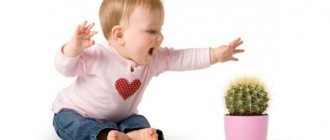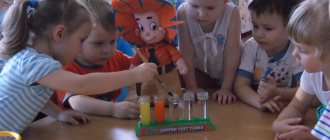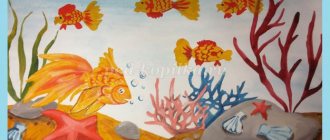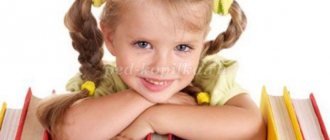Project of educational and research activities “I am a researcher”
Project “I am a researcher”
Relevance.
Experimentation
- an effective method of understanding the patterns and phenomena of the surrounding world and, more than ever, experimentation is one of the pressing problems of our time.
Children's experimentation has enormous developmental potential. Its main advantage is that it gives children real ideas about the various aspects of the object being studied, about its relationships with other objects and the environment.
The experiment enriches the child’s memory, activates his thought processes, and includes an active search for solutions to problems, i.e. experimentation is a good means of intellectual development of preschoolers.
In children's experimentation, children's own activity, aimed at obtaining new knowledge and information, is most powerfully manifested.
For preschool children, experimentation, along with play, is a leading activity.
Experimentation is closely related to all types of activities, and primarily to those such as observation and work. Observation is an indispensable component of any experiment, since with its help the perception of the progress of work and its results is carried out.
Experimentation and speech development are very closely related. This can be clearly seen at all stages of the experiment - when formulating the goal, during the discussion of the methodology and progress of the experiment, when summing up the results and giving a verbal report of what was seen.
The connection between children's experimentation and visual activity is also two-way. The more developed a child’s visual abilities are, the more accurately the result of a natural history experiment will be recorded.
The connection between experimentation and the formation of elementary mathematical concepts does not require special proof. During experiments, there is a constant need to count, measure, compare, determine shape and size, and perform other operations. All this gives mathematical concepts real significance and contributes to their understanding. At the same time, mastery of mathematical operations facilitates experimentation.
Project typology:
The project is complex in nature - it includes research, creative, educational and practical activities.
Implementation deadlines
: short-term – 2 months (February, March)
Project participants:
children of the preparatory group, parents of pupils, teachers.
Objective of the project:
“Development of cognitive abilities of preschool children through experimentation.”
Project objectives:
– to form dialectical thinking in preschool children, i.e. the ability to see the diversity of the world in a system of relationships and interdependencies;
– develop your own cognitive experience in a generalized form using visual aids (standards, symbols of conditional substituents, models);
– expand the prospects for the development of children’s search and cognitive activity by including them in thinking, modeling and transformative actions;
– support children’s initiative, intelligence, inquisitiveness, criticality, and independence.
Methods and technologies for project implementation:
project method; person-oriented technologies; educational activities and games - experimentation, conversations with children, productive activities.
Resource support for the project
.
Methodical:
1. “The unknown is nearby. Experiences and experiments for preschoolers”, Dybina O.V., Rakhmanova N.P., Shchetinina V.V., 2010
2. “Experimental activities of children of middle and senior preschool age”, Tugusheva T.P., Chistyakova A.E., 2010.
3. “Organization of experimental activities for children aged 2-7 years”, Martynova E.A., Suchkova I.M., 2011.
4. “Games with water and sand”, Ryzhova N.V., Hoop No. 2, 1997
5. “Experiments with sand and clay”, Ryzhova N.V., Hoop No. 2, 1998
6. Educational holidays and leisure activities for preschoolers. L.A. Naumova, 2003
7. Scenarios of musical calendar and folklore holidays. M.A. Davydova, 2007
8. “Secrets of water” by L. Orlova, M. Kretov, S. Leonenko. Musical director No. 2, 2013
Logistics:
– a selection of advisory material for teachers and parents;
– development of a group project, lesson notes and games
– experimentation; – selection of illustrations, children’s literature; – preparation of equipment and materials for experimentation and productive activities of children; – design of a “children’s laboratory in a group.
Stages of the project.
I. Preparatory
(motivational, informational and accumulative).
1. Preparing teachers for work.
Analysis of methodological literature.
A selection of stories, paintings, illustrations on the topic “Experiments, experimentation for preschoolers.”
Development of a long-term thematic plan for working with children.
Preparation of didactic and practical material for conducting experiments.
2.Cooperation with parents.
Design of informational and educational material in the form of mobile folders.
Development of recommendations for parents on conducting experiments with children at home.
Involving parents in participating in activities within the project:
– A selection of illustrations, paintings; collection of information.
– Creation of albums together with children on conducting experiments.
– Selection of materials and assistance in laboratory design.
3. Preparatory work with children.
– Conversation and viewing illustrations, viewing presentations on the topic “Water”, reading fiction: who are scientists; What is a laboratory and its purpose?
– Conducting experiments with objects of living and inanimate nature: water, sand, air, stones.
Approximate algorithm for a group project
Motivation for choosing a topic. Three Question Model.
1.What do we know?
Developmental questions to ask children:
– why do we need a laboratory in the group?
– Why are experiments needed?
– remember what experiments were carried out, what was learned as a result of them, what interesting things did you remember?
2. What do we want to know?
– What is a magnifying glass?
– What substances does water dissolve?
3. What do you need to do to find out?
– Purchase equipment for the laboratory for experiments.
– Carry out experiments and experiments.
– Ask your questions to parents and teachers, read books with them, look up information in encyclopedias.
- Tell each other about what you learned.
II. Practical.
Forms of organization of the educational process
In different types of children’s activities in the “Teacher – Child – Parents” system
”
Work with children
| Month (period) | Forms of work |
| February | Conversation “What is a laboratory? Why is it needed? |
| March | Experiment “What kind of water is there?” Goal: to clarify children’s understanding of the properties of water: transparent, odorless, has weight, does not have its own shape; introduce the principle of operation of a pipette and funnel. Experiment “Water is a solvent. Water purification.” Purpose: to identify substances that dissolve in water; introduce the method of water purification - filtration; consolidate knowledge about the rules of behavior when working with various substances. Integrated educational activities "Secrets of Water" Experiment “Water coloring”. Purpose: to introduce children to observation devices - a magnifying glass, to explain why a person needs them. Experiment “Multi-colored icicles”. Goal: to realize your ideas about the properties of water (transparency, solubility, freezing at low temperatures), obtained during research activities. Experiment “Solid water. " Purpose: to clarify children’s understanding of the properties of ice: transparent, hard, shaped, when heated, it melts and turns into water Conversation “The Journey of the Droplet.” Goal: to introduce children to the water cycle in nature, to identify the causes of precipitation in the form of rain and snow; expand children’s understanding of the importance of water for human life; develop social skills in children; the ability to work in a group, negotiate, take into account the partner’s ability to prove the correctness of his opinion. Educational entertainment “Water Sorceress” Together with the parents of the students. |
Design of an electronic presentation, design of a children's album on experimentation; design of an exhibition of children's drawings on the theme “Water Among Us”; presentation of the results of work with children for parents and teachers
Working with parents
| Month | Forms of work |
| February | Conversation at home with children: who are scientists; what is an experiment? |
| Invite parents to purchase for experiments: straws, pipettes, gauze, vessels of various shapes, oilcloth, mesh for experiments and experiments. | |
| March | Invite parents to conduct an experiment with water at home with their children. (Family of Kirilycheva Anya) |
| Invite parents to conduct “water coloring” experiments at home | |
| Help parents carry out experiments by bringing magnifying glasses, binoculars, and colored glasses. | |
| Organize parents for a final joint leisure-entertainment “Water Sorceress” (Parent participants: Zhurova E.V., Kirilycheva E.Yu.) |
III. Generalizing.
Assessment of the implementation of the project by children: conversation “What did we want to know, what did we learn and do, why?”
Presentation of activity products.
Expected results.
For children.
– Children will develop an idea of the relationship between nature and humans.
– Children will master ways to practically interact with the environment
– Personal qualities will be formed according to the age of the children: cognitive activity and interest, independence, creativity, initiative.
For teachers.
Generalization of teaching experience, introduction of innovative technologies and new forms of work on children's experimentation.
Increasing the theoretical and professional level of teachers through mastering the project method in working with children.
MAGAZINE Preschooler.RF
Project "Pochemuchek Laboratory"(preparatory group)
Educators:
- Fomkina A.I.
- Sigaeva E.V.
Project “Experimental activities of children of senior preschool age”
Type of project: group, long-term.
Project type: search and research.
Participants: preparatory group students, teachers, parents.
Project product: updating and replenishing the experimentation corner.
Release dates: March-April 2021
Relevance:
People who have learned to observe and experiment acquire the ability to pose questions themselves and receive factual answers to them, finding themselves at a higher mental and moral level in comparison with those who have not undergone such schooling. K. E. Timiryazev.
The world we live in is complex, multifaceted and changeable. People - part of this world - are discovering more and more new objects, phenomena and patterns of the surrounding reality. At the same time, each person revolves within the framework of the image of the world that he has formed.
During the period of preschool childhood, the emergence of a primary image of the world occurs due to the cognitive activity of the child, which has its own specifics at each age stage. The development of cognitive interest in various areas of knowledge and activities is one of the components of both the general development of a preschooler and the further success of his education at school. The preschooler's interest in the world around him and the desire to learn everything new is the basis for the formation of this quality. Throughout preschool childhood, along with play activities, cognitive activity, as a process of acquiring knowledge, skills, and abilities, is of great importance in the development of a child’s personality. Understanding the importance of search activity in the development of children’s cognitive activity and their intellectual abilities, I chose children’s experimentation as one of the activities.
There are different approaches to defining the concept of “children's experimentation” . Children's experimentation is one of the forms of organizing children's activities on the one hand and one of the types of cognitive activity on the other.
The main advantage of the experimentation method is that it gives children real ideas about the various aspects of the object being studied, about its relationships with other objects and with the environment. During the experiment, the child’s memory is enriched, his thought processes are activated, since the need constantly arises to perform operations of analysis and synthesis, comparison and classification, generalization and extrapolation. The need to give an account of what was seen, to formulate discovered patterns and conclusions stimulates the development of speech.
The consequence is not only the child’s familiarization with new facts, but also the accumulation of a fund of mental techniques and operations that are considered as mental skills.
Preschoolers are characterized by visual-effective and visual-figurative thinking, so experimentation, like no other method, corresponds to these age-related characteristics. In preschool age, he is the leader, and for the first three years he is practically the only way to understand the world.
Children's experimentation as a specially organized activity contributes to the formation of a holistic picture of the world of a preschool child and the foundations of his cultural knowledge of the world around him.
Familiarizing preschoolers with natural phenomena occupies a special place in the system of diverse knowledge about the environment, since the subject of familiarization is present, regulates, exerts its influence and continuously affects the development of the child. The result of the project is the acquired experience of seeing objects and phenomena, peering into them, developing attention, visual and auditory sensitivity, expanding vocabulary and enriching verbal communication based on cultural norms.
Objective of the project:
Practical implementation of children's experimentation as a means of developing cognitive activity.
Project objectives:
- Expand children's understanding of the world around them through familiarization with basic physical properties and phenomena; — Replenish and enrich the developmental subject-spatial environment in the group for organizing the work of preschoolers in experimental and research activities.
- Develop children's coherent speech: encourage them to reason, argue, and use evidence-based speech
- Provide a transition from objective-practical action to figurative-symbolic action (schematization, symbolization of connections and relationships between objects and phenomena of the surrounding world)
- Develop observation skills
- Introduce children to the properties of various objects and natural materials (paper, plastic, magnet, soil, water, plants, etc.).
- Stimulate the development of independence and responsibility.
- Cultivate children's interest in experimental activities
- Cultivate such qualities as the desire to help others, the ability to negotiate with each other to solve common problems.
- Creating conditions for the manifestation of research activity of older preschoolers in independent and collective experimentation.
- Maintaining children's initiative, intelligence, inquisitiveness, criticality, and independence.
Implementation conditions: group of children, specially organized environment, samples, material for work.
Teaching methods: verbal, practical, visual.
Expected result:
- Children have formed an emotional and value-based attitude towards the world around them.
- Children show cognitive interest in classes, speech development has improved.
- The foundations of dialectical thinking have been formed.
- The knowledge provided by the program has been deepened.
- The basics of a holistic vision of the world around us have been mastered.
- Communication skills have been developed.
- The necessary conditions have been created for the formation of the foundations of a preschooler’s holistic worldview through experimental activities.
- Pupils have children's ideas about the world around them.
- Preschoolers have developed the skills to observe, analyze, compare, identify characteristic, essential features of objects and phenomena, and generalize them based on these features.
- Children have expanded knowledge and ideas about the world around them, including about snow and ice.
- Children develop cognitive skills through experimental activities.
They are able to apply the skills of cognitive and research activities with water, ice and snow in everyday life.
Basic principles of organizing children's experimentation:
Scientific principle:
- involves the reinforcement of all means of cognition with scientifically based and practically proven methods
- the content of the work corresponds to the basic principles of developmental psychology and preschool pedagogy, while it has the possibility of implementation in the practice of preschool education.
Integrity principle:
- is based on the complex principle of building continuity and
continuity of the process of search and research activities;
- provides for the solution of program problems in the joint activities of teachers, children and parents.
The principle of systematicity and consistency:
- ensures the unity of educational, developmental and training tasks, the development of search and research activities of preschoolers
- assumes repetition of topics in all age groups and allows children to apply what they have learned and learn new things at the next stage of development
- forms dynamic stereotypes in children as a result of repeated repetitions.
The principle of individual-personal orientation of education:
- involves the implementation of the idea of prioritizing self-valued childhood
providing a humane approach to the holistic development of the personality of a preschool child and ensuring the readiness of the individual for its further development;
- ensures the child’s psychological security, emotional comfort, and creates conditions for self-realization based on the child’s individual characteristics.
Accessibility principle:
- involves building the learning process for preschoolers on age-appropriate forms of working with children
- provides for the solution of program tasks in the joint activities of adults and children and the independent activities of pupils
Active learning principle:
- does not involve the transfer of ready-made knowledge to children, but the organization of such children's activities, during which they themselves make “discoveries” , learn new things by solving available problem problems
- ensures the use of active forms and methods of teaching preschoolers that contribute to the development of children's independence, initiative, and creativity.
Creativity principle:
- provides for the “cultivation” of preschoolers’ ability to transfer previously developed skills in situations of independent activity, to initiate and encourage children’s needs to independently find solutions to non-standard tasks and problematic situations.
Performance principle:
- provides for obtaining a positive result of the work carried out on the topic, regardless of the level of intellectual development of children.
PROJECT IMPLEMENTATION STAGES
Stage 1 – preparatory.
- Study and analyze methodological literature on the topic
- Preparation of planning for experimental activities
- Selection of basic equipment and material to equip the experimental activity center.
Stage 2 – the main one.
Introduction of experimental activities into the educational process.
To develop children’s cognitive activity and maintain interest in experimental activities, an “Experimentation Corner” .
In the experimentation corner there are: various types of materials: natural, waste, technical, medical; food dyes, products (flour, salt, sugar, various vessels and many other items necessary for conducting certain experiments.
The corner equipment is safe for children and is stored in convenient containers.
Once a week, an educational activity is organized, during which older preschoolers learn to conduct simple experiments with living and inanimate nature. They make conclusions.
Stage 3 – final.
Presentation of the project, updating and replenishment of the experimentation corner.
Forms of work:
- In small subgroups, taking into account the level of development and cognitive interests of children.
- Frontal work.
- Individual work.
Working with parents:
- familiarizing parents with the objectives of the pilot project
- conversation “Experimental activities of preschoolers” , “The importance of experimental activities for children” , “Organization of a home laboratory”
“How to properly organize experimental activities at home”.
- Introducing parents to the experimental corner at the preschool educational institution
- Visual information
Conclusion
As a result of work on the project, it was possible to show that such a modern innovative teaching method as experimental activities can compete with traditional teaching.
We can conclude that experimentation is an effective way to teach children research activities in all its forms and types and is a method of increasing a child’s independence. Provides the prerequisites for the active development of cognitive interest in the purposeful perception of the surrounding world and is the leading activity in learning.
Experimental work arouses children's interest in exploring nature, develops mental operations (analysis, synthesis, classification, generalization, and stimulates the child's cognitive activity and curiosity.
Long-term planning of experimental activities in the senior group.
- Experiments “Does water have color, taste and smell” , “Does water have a shape?” Purpose: To make it clear to children that water is a liquid that has no shape, color, smell, or taste. Clarify children's ideas that water constantly changes shape. It takes the shape of the vessel into which it is poured. Continue to introduce the properties of water; develop observation skills; consolidate knowledge of safety rules when handling glass objects.
- Experiments “Why is snow soft” , “How snow turns into water”
Goal: Improve children's knowledge about snow. Show that snow melts in warmth, becomes water, the snow is white, but contains fine dirt - it is clearly visible through the transparent melt water.
- Experience “Sun Bunnies” Purpose: To introduce the origin of sun bunnies, their movement, the objects from which they are reflected; develop ingenuity and curiosity.
- Experimental activity “Paper and its properties”
Purpose: to introduce children to the properties of paper, to show different types of paper.
- Experimental activity “Wind and its properties” Purpose: to tell children about the nature of the occurrence of wind, its properties.
- “Magnifying glasses” Purpose: To introduce the assistant device “magnifying glass” . Explain why a person needs a magnifying glass. Develop observation and curiosity
- Solving riddles.
- Verbal games: “Like snow on a Christmas tree” “Which one is made from” (snow slide, snowy, etc., “Say the opposite .
- Didactic games “Complete the drawing” , “Find out by description” , “Winter supplies” .
- (Music) Listening to “The Seasons” by P. I. Tchaikovsky, “Waltz of Snow Flakes” from the ballet “The Nutcracker” by P. I. Tchaikovsky.
- Watching a series of cartoons "Fixies" about experimental activities
- Folk round dance games: “Blizzard” , “What we like in winter” . P/i “Two Frosts” , “Red Nose Frost” , “Fluff Snowballs” .
- Game exercises “Sliding along ice paths”
- Games with snow: “Building snowmen and fortresses”
- Didactic games on ecology: “Earth, water, and air” , “Choose the right one” , “Where are the snowflakes?
Photo supplement to the project:
THANK YOU FOR YOUR ATTENTION!
| Next > |




